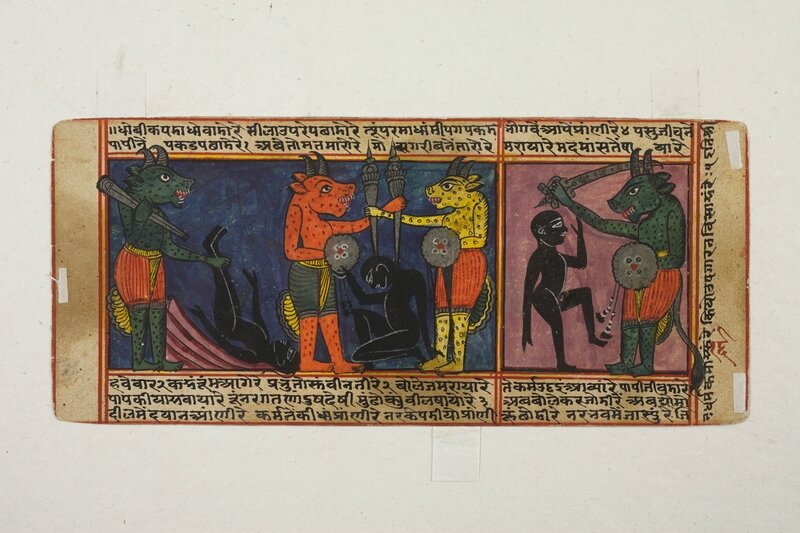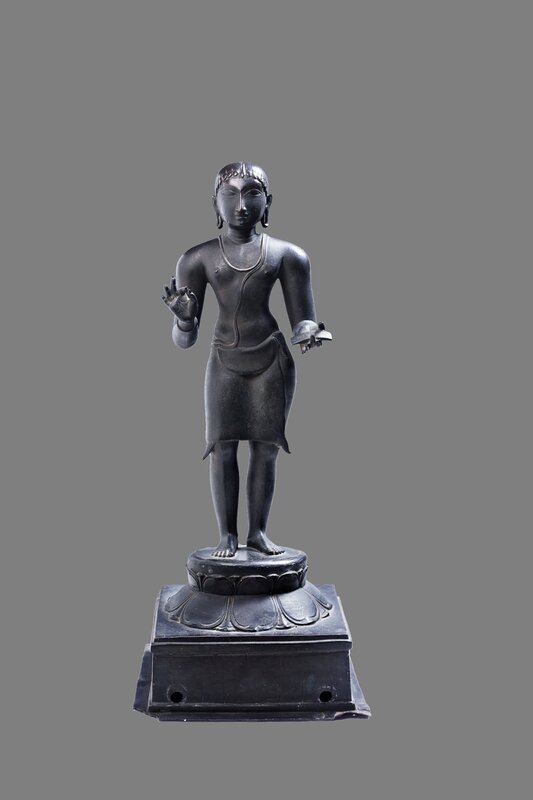Europalia-Indomania. Corps de l'Inde/The Body in Indian Art @ Palais des Beaux-Arts, Bruxelles
Surasundari (Patralekha), Chandela, 10th Century, Indian Museum, Kolkata © Bandeep Singh
BRUXELLES. - Qui pose l’œil sur la statuaire indienne, se penche sur les miniatures mogholes, s’intéresse à sa tradition de la culture physique, du massage, à la pratique de la médecine, de la danse, regarde les femmes parées de leurs saris chatoyants, observe le panthéon des dieux hindous et leurs corps extraordinaires, étudie les notions de pureté et d’impureté si cruciales dans la société indienne… ne peut qu’être frappé par l’omniprésence du corps dans l’art et la culture indienne.
The Universe and the terrestrial sphere © Hock Khoe
Tour à tour sensuel, intouchable, orné, sacré, outil ou obstacle ; c’est parce que le corps permet d’aborder tant d’aspects de la culture indienne que nous l’avons choisi comme thème central de l’exposition d’ouverture du festival.
Radha Krishna on the banks of the Yamuna. A folio from the Gita © Hock Khoe
L’exposition permettra au visiteur de comprendre la complexité liée à la notion de corps en Inde, et les nombreuses facettes sous lesquelles il peut être perçu. Divisée en huit chapitres, elle abordera à travers sculptures, miniatures, textiles et bijoux, des thématiques religieuses, esthétiques, philosophiques ou cosmologiques. En traversant les siècles et en élucidant le temps du parcours les fondamentaux de l’Inde, l’exposition permettra une meilleure compréhension de ses cultures et de son art. Le visiteur devrait y trouver de quoi réjouir ses sens et son esprit.
Three headed Shiva with Nandi Prithvi and a gana, North-west India, Punjab Salt Hills, 7th-8th Century, limestone, ht 58cm © John Eskenazi
Cette exposition spectaculaire rassemblera plus de 250 chefs d’œuvre d’environ 50 musées, instituts archéologiques et collections privées à travers l’Inde. Elle explorera la notion complexe de corps et les multiples aspects qu’elle peut englober. Des sculptures monumentales en pierre issues des réserves de petites villes de province, aux bronzes Chola de Tanjore et aux manuscrits de magie peints pour l’empereur moghol Akbar et conservés au sein de la légendaire bibliothèque des Nababs de Rampur ; l’exposition permettra au spectateur de se confronter à des œuvres d’exception, parmi lesquelles beaucoup n’ont jamais été exposées, ni même publiées.
Jain cosmogram, Jambudweep on cotton, 17th Century; 162x160cm, Ajit Mookerjee collection, National Museum, New Delhi © Hock Khoe
Corps de l’Inde étudie à travers un cadre conceptuel unique la manière dont l’art indien a représenté le corps et comment il a traité des tenants et aboutissants de ce vaste et crucial sujet. Le spectateur est invité à se pencher sur les aspects inhérents au corps, et à questionner ce qui l’anime. Que reste-t-il des archétypes sociétaux de l’héroïsme? Qu’est-ce qui motive à l’abstinence et à l’ascétisme ? Comment la civilisation aborde-t-elle les rites de passage, la mort et la naissance ? Dans quelle mesure les Indiens croient-ils le destin du corps prédéterminé ?
Kubera, Stone, Kushana, 2nd Century; 96,5x45,5x36cm, National Museum, Delhi © Hock Khoe
Cette exposition révèle le corps non seulement comme un sujet artistique, mais également comme un medium utilisé au fil des siècles pour transmettre valeurs, préoccupations et aspirations. Chaque étape du parcours raconte une fascinante pluralité, et évite de proposer un point de vue unique. La multiplicité des corps et des interprétations s’explique par la diversité géographique, chronologique et religieuse ; tout comme par la variété des commanditaires et matériaux utilisés.
Radha removing the Veil from Kṛishna's Face, Guler Kranga, ca 1780, Chandigarth Museum and Art Gallery © Hock Khoe
Les questions posées dans chaque salle sont universelles, existentielles. Cette exposition riche, aux multiples niveaux de lecture réexamine aussi les classiques à la lumière de notre regard actuel sur l’exclusion sociale, les genres et la sexualité. Certaines salles juxtaposeront idées et œuvres d’art indiennes classiques avec des œuvres majeures de l’art contemporain traitant de préoccupations similaires.
Carving of a squatting woman giving birth, Ajit Mookerjee Collection, National Museum, Delhi © Hock Khoe
BRUSSELS. - Whoever admires Indian statuary or Moghul miniatures, who is interested in its tradition of physical culture, massage, the practice of medicine, dance, who observes Indian women dressed in their shimmering saris, or the pantheon of Hindu gods and their extraordinary bodies, who studies the concept of purity and impurity that is so crucial in Indian society… cannot help but be struck by the omnipresence of the body in Indian art and culture. Alternating between sensual, untouchable, adorned, sacred, tool or obstacle, it is because the body touches upon so many aspects of Indian culture that we have chosen it as the central theme of the festival’s opening exhibition.
Karni bharni, gouache on paper, 18th Century, Ajit Mookerjee © Collection National museum, Delhi
The Body in Indian Art has used a unique conceptual framework to examine the ways in which Indian art has represented/ treated the intricacies of the vast and germane subject of the ‘body’. Through the curator’s vision the viewer is invited to explore what inheres within the body, and to question what drives Indian bodies. Where do society’s archetypes of heroism and valour rest, for example? What motivates abstinence and asceticism? How does a civilisation view the rites of passage, death, and birth? To what extent do Indians believe that the body’s fate is destined / predetermined, and to what degree is fortune in the hand of those people who shape it for themselves?
Manikkavacakar, Chola, 10th Century, Bronze, National Museum Delhi © Hock Khoe
This exhibition importantly reveals the body not only as the subject of art, but also as the medium used to convey the values, preoccupations and aspirations of the times. What emerges is a complex plurality where no gallery presents a singular view. The multiplicity is born of the diversity in geography, chronology, patronage, religion and art material that is present in every gallery of the exhibition. The questions posed in each gallery are universal, existential ones, but Ahuja has taken care not to fall into the trap of simplification for the sake of communicating any singular teleology. Through art, he has shown the body as a site for defining individual identity, negotiating power, and experimenting with the nature of representation itself. This is a richly layered exposition that also re-examines the classical in light of our changing views of social exclusion, gender and sexuality.
The Nativity of Mary, Mughal miniature, ca 1725 © Collection National museum, Delhi
The Body in Indian Art brings together 250 masterpieces from approximately 50 of India’s museums, archaeological institutes, and private collections, in an exploration of the complex and multifaceted understandings of the ‘Body’.
The exhibition will be divided into eight chapters, in which sculptures as well as miniatures, textiles and jewels enter upon religious, aesthetic, philosophic, and cosmologic themes. The ensemble of objects reflects the diversity and splendour of India’s art. Ranging from monumental stone sculptures located in the storerooms of provincial smalltowns, to Chola bronzes from Tanjore, and manuscripts about magic painted for the Mughal Emperor Akbar from the fabled library of the Nawabs of Rampur, the exhibition provides the spectator with examples of artworks of unparalleled excellence, many of which have never before been publicly exhibited, nor published.
Composite anthropomorphic figure, cuivre, Prehistoric period, Central antiquity Collection, secton AGI PURADANA, Delhi Hock Khoe

/https%3A%2F%2Fprofilepics.canalblog.com%2Fprofilepics%2F1%2F0%2F100183.jpg)
/https%3A%2F%2Fstorage.canalblog.com%2F03%2F02%2F119589%2F96711876_o.jpg)
/https%3A%2F%2Fstorage.canalblog.com%2F11%2F31%2F119589%2F94773502_o.jpg)
/https%3A%2F%2Fstorage.canalblog.com%2F20%2F83%2F119589%2F94772815_o.jpg)
/https%3A%2F%2Fstorage.canalblog.com%2F26%2F72%2F119589%2F75604929_o.jpg)
/https%3A%2F%2Fstorage.canalblog.com%2F59%2F60%2F119589%2F26458628_o.jpg)














/http%3A%2F%2Fstorage.canalblog.com%2F32%2F99%2F119589%2F129836631_o.jpg)
/http%3A%2F%2Fstorage.canalblog.com%2F46%2F82%2F119589%2F129704536_o.jpg)
/http%3A%2F%2Fstorage.canalblog.com%2F49%2F48%2F119589%2F129680938_o.jpg)
/http%3A%2F%2Fstorage.canalblog.com%2F64%2F83%2F119589%2F129635530_o.jpg)